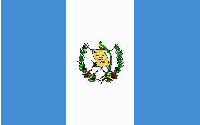 Of the seven nations in Central America, Guatemala is by most measures the
most important. It contains one third of the region's population and surpasses other Central
American countries in commerce and manufacturing. With more than 1 million inhabitants, its
capital city also called Guatemala is by far the largest urban center in Central America. That
Guatemala was equally distinguished before the arrival of the Spanish is revealed by the
widespread distribution of major Mayan archaeological sites.
Of the seven nations in Central America, Guatemala is by most measures the
most important. It contains one third of the region's population and surpasses other Central
American countries in commerce and manufacturing. With more than 1 million inhabitants, its
capital city also called Guatemala is by far the largest urban center in Central America. That
Guatemala was equally distinguished before the arrival of the Spanish is revealed by the
widespread distribution of major Mayan archaeological sites.
Official Name. Republic of Guatemala.
Capital. Guatemala City.
Area. 42,042 square miles (108,888 square kilometers).
Population (1991 estimate). 9,177,000; 218.3 persons per square mile (84.3 persons per
square kilometer); 35 percent urban, 65 percent rural.
Major Language. Spanish (official).
Major Religion. Roman Catholicism.
Literacy. 60 percent.
Highest Peak. Tajumulco.
Major Rivers. Motagua, Polochic, Sarstun, Usumacinta.
Form of Government. Republic.
Head of State and Government. President.
Legislature. National Congress.
Voting Qualifications. Age 18 and over; compulsory for those who are literate, optional for
illiterates.
Political Divisions. 22 departments.
Major Cities (1991 estimate). Guatemala City (1,095,700), Mixco (348,500), Villa Nueva
(125,200), Quezaltenango (93,400), Escuintla (63,500).
Chief Manufactured and Mined Products. Beverages, cement, clothing, flour, food
processing, matches, pharmaceuticals, shoes, soap, textiles, tires, tobacco.
Chief Agricultural Products. Crops bananas, beans, coffee, corn, cotton, rice, sugarcane,
wheat. Livestock cattle, pigs.
Monetary Unit. 1 quetzal = 100 centavos.